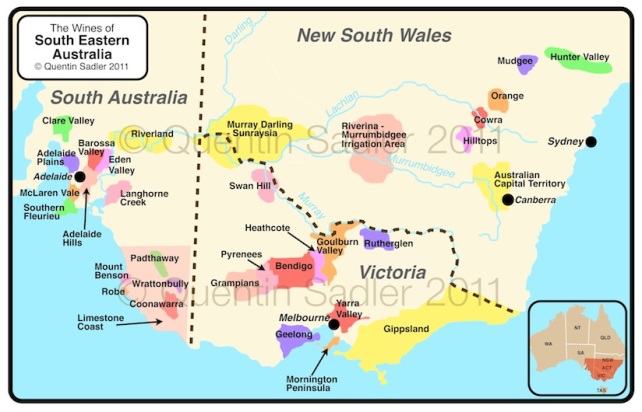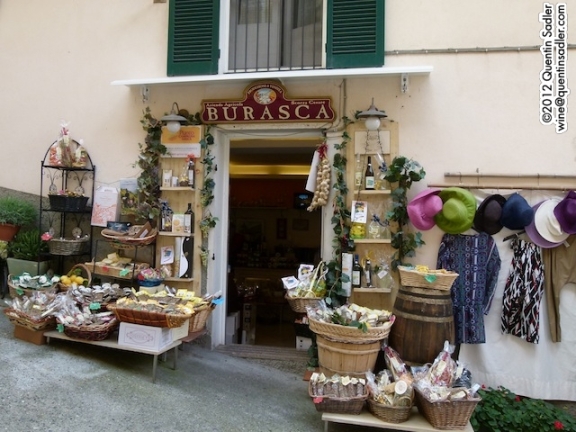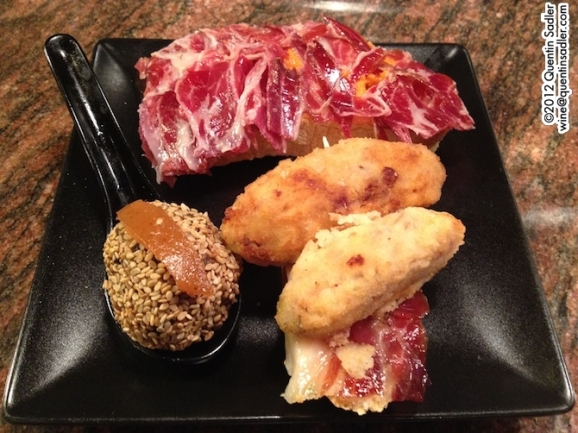Variety is the spice of life. We have all heard that old saying and most of us know that there is some truth in it.
Certainly I like variety in wine. I am never more excited by a wine than when I am tasting it for the first time, or experiencing a grape variety or region that is new to me.
I suppose that is why I find Spanish, Greek and Italian wines so interesting, there is such great variety in all those places. Of course France does offer variety – but the whole focus on established classic wine styles means that there are normally fewer big surprises.

Vineyards at Château Clément Termes – photo courtesy of Château Clément Termes.
One ‘classic’ region of France though seems to be capable of delivering enough surprises for everyone. That region is the Southwest or Sud-Ouest and with the wines from here you never know what you’re going to get.
Actually that isn’t entirely true, but there is enormous variety here. That is because it isn’t really one region at all, but a mosaic made up of lots of small wine regions or sub-zones, many very traditional and some quite famous, but all believing they have more clout and potential together than they do divided.
As you can see from my map the region covers great swathes of France:

Map of Southwest France – click for a larger view – non watermarked PDF versions are available by agreement.
Dordogne and Bergerac – wines here are very Bordeaux-like and include Bergerac, Côtes de Duras and Monbazillac.
The Garonne – wines here are more varied in style and include Buzet, Côtes du Marmandais, Cahors and Gaillac.
Gascony – for me this is very much the heart of the Southwest and wines include Madiran, Pacherenc du Vic-Bilh and Saint-Mont, as well as the excellent Côte de Gascogne IGP / Vin de Pays wines from the Armagnac region.
The Basque Country and Béarn – nestling in the Pyrenees these sub-zones produce Jurançon, Béarn and Irouléguy.
I find myself very drawn to the wines from this part of the world, because of the variety, that feel of the unexpected and the fact that they are honest country wines made by farmers in remote sounding backwaters. These are wines that with some exceptions are slightly out of the mainstream, beloved by the locals and the people who make them, but a difficult thing to sell on more international markets. All of which makes them fascinating and worth trying when you get the chance – oh and lest I forget, on this showing they taste really good too!
This part of the world is also home to some interesting Vins de Pays or IGP – Indication Géographique Protégée – as we now call them. As well as Côte de Gascogne, the other IGPs are; Côtes du Tarn, Côtes du Lot, Ariège, Landes, Condomois and Gers, while the whole region is covered by IGP du Comté Tolosan.
Recently I was able to try a really interesting range of wines from this part of the world and I thought they showed extremely well and convinced me that they were deserving of a wider audience and more of a following than they seem to enjoy at the moment – what’s more they offer really good value for money.
White Wines
I found these an exciting bunch of wines, really well made and giving lots of pleasure. The first 2 came from the Côte de Gascogne and were superb examples from star producers, both of whom I have known for a long time – and indeed used to sell once upon a time.
 2012 Domaine de Grachies Côte de Gascogne Sec
2012 Domaine de Grachies Côte de Gascogne Sec
Vignobles Fontan
Aline et Jean-Claude Fontan own 2 estates Domaine de Maubet and Domaine de Grachies and both make lovely wines, Floc de Gascogne and Armagnac. For many years I used to sell their delightful Domaine de Maubet (sometimes Domaine de Grachies) Gros Manseng Cuvée Coup de Coeur, which was a little sweet and simply stunning with melon and ham.
This is a simple and utterly delicious zesty dry aromatic white made from a blend of 45 % Colombard, 30 % Ugni blanc, 15 % Gros Manseng, 10 % Sauvignon Blanc. It is light-bodied, zesty and very fruity in a richly citrus way and will go with almost anything from being nice on its own to fish and chips and spicy foods – every fridge needs some of this in the summer! Not a complex wine, but gives great pleasure – 86/100 points.
Available in the UK at £6.75 per bottle from Nethergate Wines.
Domaine de Grachies Gros Manseng Cuvée Coup de Coeur is also available from Nethergate Wines.
The estate also has a gîte.
 2011 Domaine du Tariquet Les 4 Réserve Côte de Gascogne Sec
2011 Domaine du Tariquet Les 4 Réserve Côte de Gascogne Sec
Château du Tariquet,Yves Grassa
Altogether more ambitious, this took me a little while to get the hang of, but once I did I loved it – although I think Tariquet’s Classic dry white and their stunningly good Côté Tariquet Sauvignon-Chardonnay blend might prove bigger crowd pleasers – this is a blend of 45% Gros Manseng, 35% Chardonnay, 15% Sauvignon, 5% Sémillon all aged for 12 months in oak barrels. The oak does not dominate though, just adds texture and complexity. This is dry, but with big fruit and a touch of weight and softness to the palate – 86/100 points.
Available in the UK at £11.50 per bottle from Next Wine – I had no idea Next did wine!
Tariquet wines are available in the US through Robert Kacher Selections.
Different, but equally good, Fontan wines and Tariquet wines are also available in the UK from The Oxford Wine Company.
Gaillac
I have heard about Gaillac all my working life – the very lightly sparkling Gaillac Perlé was widely listed in the 1970s and ’80s – but have never in the past been especially excited about them. I cannot imagine why, I thought the 2 I tasted the other day were lovely wines and entirely different from the Gascogne contingent, these were dry and stony with taut green fruit. What’s more they are absolute bargains:
 2012 Château Clement Termes
2012 Château Clement Termes
Gaillac Blanc Perlé
A blend of Muscadelle with Loin de l’Oeil / Len de l’el aged on the lees over winter. At only 12% this is delightfully light and fresh with high but not tart acidity, scented and herbal with green tinged fruit and a nettle-like, stony character. If you enjoy Sauvignon Blanc I cannot imagine you not falling for this wines’s delicate, linear charms, certainly I intend to drink much more of this stuff in the future. That tiny hint of spritz keeps it fresh and emphasises the savoury side too, which makes it a lovely aperitif or serve with anything light – the back label proclaims it to be ‘indispensable with fruits de mers’ and I would love to try it with goats cheese some time – 86/100 points.
Available in the UK at £7.50 per bottle from Underwood Wine Warehouse & The Smiling Grape Company.

Vineyards at Château Clément Termes – photo courtesy of Château Clément Termes.
 2012 Saint Michel
2012 Saint Michel
Gaillac Blanc Perlé
Les Vignerons de Rabastens
A blend of Loin de l’Oeil / Len de l’el, Muscadelle and Mauzac this time and although the 2 wines are not massively different this does have a little more weight, feeling fuller in the mouth – but it is still light and fresh with that stony, flinty minerality and high acidity without being tart. A lovely versatile dry white wine that again only has 12% alcohol – 86/100 points.
Available in the UK at £7.99 per bottle from Majestic Wine Warehouses.
Reading about the grapes used in Gaillac I can see why the world might have ignored them in the past. Some of them, it appears, are prone to oxidation and so before modern wine making techniques came they would not have made wines anything like the modern examples. The same is true for a lot of the white wines of Spain, Portugal and Italy – they had to wait for modern know-how and equipment for their local grapes to produce world-class white wines.
Saint Mont
Originally known as Côte de Saint Mont when it was created as a V.D.Q.S. – a sort of junior A.C. or aspirant appellation – in 1981, but changed its name to just Saint Mont when it was promoted to full A.C. status in 2007. The area is home to some of the oldest working vines in France – up to 150 years old – some of which are grape varieties that are unknown anywhere else in the world.
 2011 Saint Mont Les Vignes Retrouvées
2011 Saint Mont Les Vignes Retrouvées
Plaimont Producteurs
Made from a blend of 60% Gros Manseng, 20 % Petit Courbu and 20% Arrufiac, this is an exciting wine, dry, medium-bodied and tangy with a rich citrus acidity and a richer stone fruit and pithy citric palate with texture and a juicy succulence – 88/100 points.
Available in the UK at £10.00 per bottle from Les Caves de Pyrène & The Smiling Grape Company.
Red Wines
So, the whites were terrific, but the reds were good too and again there was a lot of variety with very different textures and structures to the different wines.
 2010 Domaine d’Escausses La Croix Petite
2010 Domaine d’Escausses La Croix Petite
Gaillac
La Croix Petite – named after a small stone cross in the vineyard – is a blend of 45% Fer Servadou, 45% Syrah, and 10% Cabernet Sauvignon, 1/3 of which is aged in new Allier oak barrels. I don’t drink much Fer, but when I do I always like it and wonder why it isn’t more popular and widely grown. It always has supple fruit and beautifully soft and drinkable tannins that are very agreeable even in everyday wines.The fruit here is beautifully ripe, almost creamy in fact with blackberry, vanilla and sweet spices and black pepper, the tannins give a gentle chalky feel and there is a touch of iron too. A savoury wine that demands food, but is really delicious – 89/100 points.
Available in the UK from Les Caves de Pyrène
 2010 Saint Mont L’Empreinte de Saint Mont
2010 Saint Mont L’Empreinte de Saint Mont
Saint Mont
Plaimont Terroirs & Châteaux
The Plaimont cooperative are rightly well known for making very good quality wines and this is no exception. This Tannat and Pinenc – the local name for Fer Servadou is concentrated, weight, but soft, supple and richly fruity. In fact the key word is soft, it is also very smooth with no obvious tannin feel and very drinkable, as there is also a freshness running through it that stops it being jammy – 87/100 points.
2008 vintage available in the UK at £14.99 per bottle from Vinopic.
 2010 Domaine de Berthoumieu Cuvée Charles de Batz
2010 Domaine de Berthoumieu Cuvée Charles de Batz
Madiran
Didier Barré makes some of the finest of all Madiran at Domaine de Berthoumieu, which his family have owned since 1850. Charles de Batz is his top cuvée, a blend of 90% Tannat and 10% Cabernet Sauvignon made from very old vines hand harvested and aged for 12 months in new oak barrels. Charles de Batz by the way was the inspiration for my favourite hero in literature, D’Artagnan. This is a great wine, dark concentrated and brooding with aromatic black fruit, smoke and spice on the nose. The palate is rich and dry with deep black fruit, round spice, sweet oak spice, espresso, mocha, surprisingly smooth tannins and a touch of bitter chocolate. I liked the firmness that it shows now, but it will soften and become more complex for quite a few years yet. A lovely classic food wine that will appeal to lovers of claret and Syrah – 91/100 points.
2009 vintage available in the UK at £17.99 per bottle from The Smiling Grape Company other UK stockist information available from Boutinot.

Pacherenc du Vic-Bilh & Madiran vineyards – photo courtesy of winesofsouthwestfrance.com.
Sweet Wine
This part of France is home to many excellent dessert wines, of course Sauternes and Barsac are not far away, while Monbazillac and Saussignac produce very similar wines from the same grape varieties in nearby Bergerac.
The speciality regions for sweet wines in the Sud-Ouest proper though are Jurançon, which uses the wonderful Petit-Manseng to great effect, and Pacherenc du Vic-Bilh. This PDO / AOC covers the same territory as Madiran, but is only for white wines made from Arrufiac, Courbu, Gros Manseng, Petit Courbu and Petit Manseng. Wines labelled Pacherenc du Vic-Bilh Sec are dry.
 2011 Pacherenc du Vic-Bilh Saint-Albert
2011 Pacherenc du Vic-Bilh Saint-Albert
Plaimont Producteurs
A late harvest wine made from a blend Gros Manseng, Petit Manseng and Petit Courbu left to ripen on the vine until 15 November – Saint Albert’s day. It really is delicious as it seems very fresh and lively with the sweetness keeping in the background, there are some orange marmalade notes, apricot and something more exotic about it too and the acidity keeps the luscious sweetness from dominating your palate. A lovely, beautifully balanced dessert wine, not massively complex, but very attractive – 90/100 points.
Available in the UK at £13.99 per 50 cl bottle from Corney & Barrow.
I know this selection is small, but I have tried many other wines from this varied region, and my conclusion would be that these are wines well worth trying. There are lovely wines here, interesting styles, interesting grape varieties and a whole range of wines that feel classic, but with a twist.
If you want to drink classic European wines – dry, elegant and restrained, then do try more of the wines of Spain, Italy, Portugal and Greece, but for sheer variety, difference and value for money you can add Southwest France to that list too.

 2016 Jim Barry Assyrtiko
2016 Jim Barry Assyrtiko





























































































